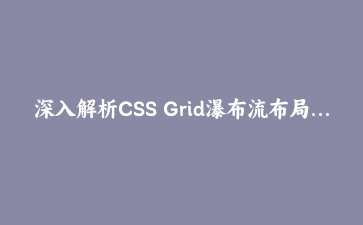HTML5 Canvas粒子动画实现指南
在现代Web开发中,Canvas API为创建高性能图形和动画提供了强大支持。本文将深入探讨如何使用HTML5 Canvas创建令人印象深刻的粒子效果动画,这是许多网站背景和游戏开发中常用的技术。
1. Canvas基础设置
首先我们需要在HTML中创建一个canvas元素,并设置其尺寸:
<canvas id="particleCanvas"></canvas>
<script>
const canvas = document.getElementById('particleCanvas');
const ctx = canvas.getContext('2d');
// 设置canvas尺寸为窗口大小
function resizeCanvas() {
canvas.width = window.innerWidth;
canvas.height = window.innerHeight;
}
window.addEventListener('resize', resizeCanvas);
resizeCanvas(); // 初始化尺寸
</script>2. 创建粒子类
粒子是动画的基本单位,我们需要定义一个粒子类来管理每个粒子的属性和行为:
class Particle {
constructor(x, y) {
this.x = x;
this.y = y;
this.size = Math.random() * 3 + 1;
this.speedX = Math.random() * 3 - 1.5;
this.speedY = Math.random() * 3 - 1.5;
this.color = `hsl(${Math.random() * 360}, 100%, 50%)`;
}
update() {
this.x += this.speedX;
this.y += this.speedY;
// 粒子尺寸随时间减小
if (this.size > 0.2) this.size -= 0.05;
}
draw() {
ctx.fillStyle = this.color;
ctx.beginPath();
ctx.arc(this.x, this.y, this.size, 0, Math.PI * 2);
ctx.fill();
}
}3. 粒子系统实现
接下来我们创建一个粒子系统来管理所有粒子,并实现动画循环:
const particles = [];
function createParticles(x, y) {
for (let i = 0; i < 10; i++) {
particles.push(new Particle(x, y));
}
}
function handleParticles() {
for (let i = 0; i < particles.length; i++) {
particles[i].update();
particles[i].draw();
// 移除太小的粒子
if (particles[i].size {
createParticles(e.x, e.y);
});4. 实时演示
移动鼠标查看粒子效果
// 演示代码
const demoCanvas = document.getElementById(‘demoCanvas’);
const demoCtx = demoCanvas.getContext(‘2d’);
class DemoParticle {
constructor(x, y) {
this.x = x;
this.y = y;
this.size = Math.random() * 5 + 1;
this.speedX = Math.random() * 3 – 1.5;
this.speedY = Math.random() * 3 – 1.5;
this.color = `hsl(${Math.random() * 360}, 100%, 50%)`;
}
update() {
this.x += this.speedX;
this.y += this.speedY;
if (this.size > 0.2) this.size -= 0.05;
}
draw() {
demoCtx.fillStyle = this.color;
demoCtx.beginPath();
demoCtx.arc(this.x, this.y, this.size, 0, Math.PI * 2);
demoCtx.fill();
}
}
const demoParticles = [];
function createDemoParticles(x, y) {
for (let i = 0; i < 5; i++) {
demoParticles.push(new DemoParticle(x, y));
}
}
function handleDemoParticles() {
for (let i = 0; i < demoParticles.length; i++) {
demoParticles[i].update();
demoParticles[i].draw();
if (demoParticles[i].size {
const rect = demoCanvas.getBoundingClientRect();
createDemoParticles(e.clientX – rect.left, e.clientY – rect.top);
});
5. 性能优化技巧
为了确保粒子动画在各种设备上都能流畅运行,可以考虑以下优化:
- 限制粒子数量:设置最大粒子数,避免内存泄漏
- 使用requestAnimationFrame:而不是setInterval或setTimeout
- 减少重绘区域:只重绘发生变化的部分
- 使用离屏Canvas:对于复杂的粒子可以预先渲染
6. 扩展应用
掌握了基础粒子效果后,你可以尝试以下扩展:
- 添加重力效果,使粒子自然下落
- 实现粒子间的连线效果,创建网络结构
- 根据音乐节奏生成粒子
- 创建烟花爆炸效果
Canvas粒子动画为Web开发带来了无限可能,希望本文能帮助你入门这一技术领域。通过不断实践和探索,你可以创造出更加复杂和吸引人的视觉效果。














